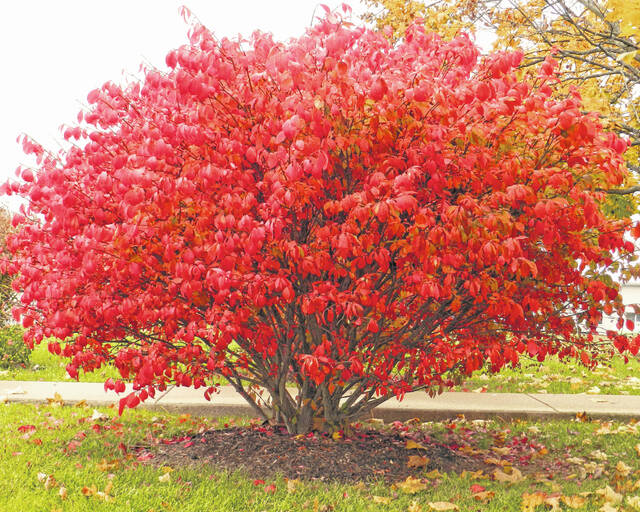

Few landscape shrubs are as well known as the “burning bush” (Euonymus alatus or “winged euonymus”), a woody shrub known for its spectacular red fall color. The term “winged” Euonymus refers to the corky bark that forms on their mature stems.
Burning bush is a handsome and rugged plant that will grow in bad soils and tolerate drought. It is deer resistant. Left un-sheared, burning bush develop a graceful horizontal branching habit that looks like a miniature version of a stately shade tree.
Many varieties of burning bush will grow over twelve feet tall and wide if not sheared. The most popular burning bush is “compacta” or “compactus”, a “dwarf” form that eventually grows to eight feet tall and wide.
Most homeowners routinely shear burning bush to sizes ranging from three to five feet, destroying its natural shape and causing the center to die out. Repeated shearing encourages dense branching around the outside of the bush, which deprives the inner branches of sunlight and kills them.
There are actually only two truly dwarf varieties of burning bush: “Rudy Haag”, which grows to five feet, and “Little Moses”, a new cultivar that matures between three and four feet.
These varieties are more suited to foundation plantings than “compacta”. They can grow to full size without shearing and still fit your landscape. There’s also an unusual tree form variety, a handsome shrub on a two-foot tall trunk.
These dense small trees are ideal for privacy screening.
Modern burning bush varieties are derived from native Euonymus, which thrive in southern Ohio woodlands. Like their wild cousins, burning bush form small berries that are attractive to birds.
Birds also like the dense branching and thick cover of mature burning bush, where they can safely build nests and raise their young. Burning bush can be invasive; some naturalists suggest controlling it when it starts to spread in woodlands.
The name “burning bush” comes from a story in the Bible (Exodus 3:1-6). Moses had grown up in Egypt in the palace of the Pharaoh. He ran away from Egypt after he killed an Egyptian that was beating up a Hebrew, and lived in the desert with the Midianites.
It was here that God taught Moses what he would need to know to lead the Israelites from slavery in Egypt. One day he saw a bush that appeared to be on fire, but it wasn’t burning.
Using the bush as a medium, God called Moses to service in the Promised Land.
At this time of year, burning bush show off the blazing red fall color that earned them their name.
If you decide to plant one, make sure you space it far enough from walls or pavement that it can grow to full size without constant shearing.
Steve Boehme is a landscape designer/installer specializing in landscape “makeovers”. “Let’s Grow” is published weekly; column archives are on the “Garden Advice” page at www.goodseedfarm.com. For more information is available at www.goodseedfarm.com or call GoodSeed Farm Landscapes at (937) 587-7021.



